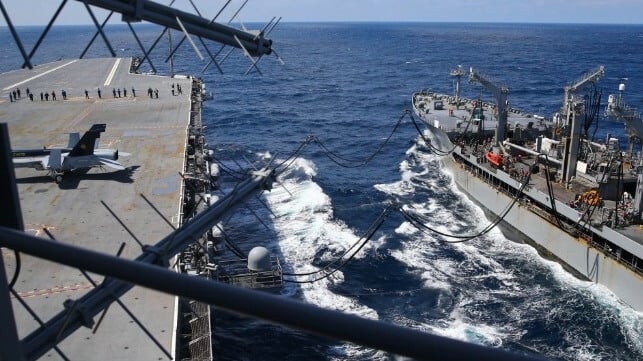Op-Ed: U.S. Sealift Forces Are Unprepared for a Fight in the Pacific

[By Andrew Rolander]
The US Transportation Command’s Military Sealift Command (MSC), the subordinate organization responsible for strategic sealift, is unprepared for the high-intensity fighting of a war over Taiwan.
In the event of such a war, combat commanders would look to MSC’s approximately 125 ships to transport about 90 percent of US Army and Marine Corps equipment into the Western Pacific for combat operations: fuel, ammunition, vehicles, missile launchers, spare parts and more.
MSC readiness levels have dropped to 59 percent, due mostly to vessel material condition and age. Most of its sealift ships are reaching an age at which maintenance and repair costs are ballooning, and service-life extensions won’t improve readiness.
Most alarmingly, current estimates indicate that the sealift fleet will lose 90,000 to 180,000 square meters (1 million to 2 million square feet) of capacity each year as ships reach the end of their useful life. That compares with the current capacity of about 840,000 square meters (9 million square feet).
Recent fleet exercises also indicate that most of MSC’s vessels cannot complete long voyages or are completely non-mission-capable. Without immediate investment, sealift will remain largely incapable of supporting major sustained combat operations.
US planning takes for granted that sea lines of communication will be contested from homeport in the United States to theatre in the western Pacific. Contested logistics add an additional layer of complexity for war planning, specifically because MSC’s strategic sealift fleet, already stretched thin and atrophied, would be subject to attack. Ships and their cargoes would be lost.
The US Transport Command will likely have to activate its Voluntary Intermodal Sealift Agreement (VISA), which allows access to civilian commercial shipping to supplement military sealift capacity. While VISA enables increased lift capacity on paper, that comes with an implied trade-off: every commercial vessel seconded to military service is lost to US commercial capacity and revenue. There is also a risk that commercial shippers will suffer grievous losses in maritime combat. The government could compensate them, but their businesses would be badly damaged.
In 2017, the US Maritime Administration estimated that US civilian merchant shipping was 1800 qualified mariners short of requirements. Since then, that number has almost certainly increased. Obviously, in the event of a major mobilization, the US will need sailors for its merchant ships.
The MSC’s strategic sealift fleet is woefully inadequate. While VISA may ease some of the inadequacy, it is unclear how effective civilian vessels would be in wartime. Moreover, even if the transport command activated VISA, the civilian merchant fleet would likely be crippled by a potentially fatal lack of interoperability among crews for want of shared experience. The US also faces a critical shortage of trained personnel.
The US Transport Command must take immediate steps to mitigate US sealift’s capability and capacity gaps. Failing this, the US and its regional allies and partners that also rely on US sealift face defeat. This is not because the US military cannot fight and win, but because the US military cannot support and sustain itself at scale on the other side of the Pacific.
Recapitalising the sealift fleet must be the MSC’s primary focus. The US needs to breathe new life into its domestic industrial base and revitalise its ability to rapidly construct ships. Fleet modernization will obviously require building ships, but the US should also consider buying foreign vessels to bolster its merchant fleet until production capacity improves.
The US Merchant Marine must improve mariner recruitment and retention. No amount of new shipping or industrial capacity will make up for a lack of qualified sailors. The maritime administration should consider new incentive programs to bring talent to crews and vessels.
While it is vital to reinvigorate the US shipbuilding industry, and to attract and retain qualified sailors, these actions alone are not enough. The MSC must also conduct regular theatre-level exercises to train the sealift force and develop interoperability in the event VISA is activated. Fleet exercises lay bare problems in peacetime, providing the advantage of time to think through those problems.
In a war, any level of sustained attrition would quickly turn catastrophic without sufficient sealift. Underpinning all of this is the need to develop a comprehensive national maritime strategy. Such a strategy must align US policy objectives with resources and reality in the Pacific. This process is likely to be uncomfortable and require trade-offs, but it is fundamentally necessary. The alternative is almost certainly humiliating defeat for want of weapons, ammunition, fuel and equipment.
General John J Pershing, himself keenly aware of logistics, said ‘infantry wins battles, logistics wins war’. His axiom has likely never been truer. It is time to recognize that the US maritime logistics problem must be solved.
Andrew Rolander is an irregular warfare and strategic competition analyst supporting the US Department of Defense. The views expressed in this article are those of the author and do not reflect the official policy or position of the US Department of Defense or the US government.
This article appears courtesy of The Strategist and may be found in its original form here.
The opinions expressed herein are the author's and not necessarily those of The Maritime Executive.
